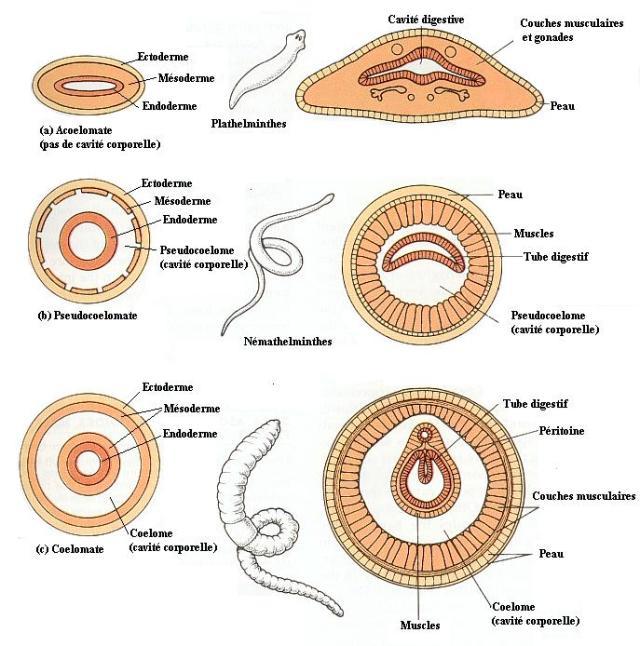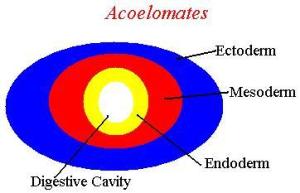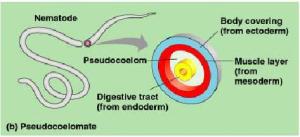COELOM
The space between the two layers of mesoderm is reffered to as coelom.

Evolution of the body cavity is the third key transition in the evolution of the animal body plan. The evoluation of efficient organ systems was not possible until the evolution of a body cavity around the gut for supporting organs and distributing materials. So coelom has an importance in evolution in animal body.
Coelom plays an important role in the classification of triploblasstic animals. So coelom has taxonomical importance.
According to the presence or obsence of coelom, triploblastic animals are differentiated into
1. Acoelomates
2. Pseudo coelomates
3. Coelomates
1. Acoelomates:
 In acoelomates triploblastic animals, the space between the body wall and alimentary canal is filled by mesenchymal cells, muscle fibres. So space does not exist. Hence the condition is ‘acoelom’ and these animals are referred as acoelomates.
In acoelomates triploblastic animals, the space between the body wall and alimentary canal is filled by mesenchymal cells, muscle fibres. So space does not exist. Hence the condition is ‘acoelom’ and these animals are referred as acoelomates.
e.g.: Platihelminthes.
• flat wroms of phylum platihelminthes are acoelomates. They exhibit solid bauplan with a dense paranchyma between the gut and the body wall in the adults. The parenchyma comprises cells and small lacunae. The space around the internal organs is filled with paranchyma. Hence there is no body cavity surrounding the integral organs. Paranchyma restricts the movement of the internal organs.
2. Pseudocoelomates: coelom or space between the body wall and the alimentary canal exists . But it is not covered by coelomic epithelical layers. So the coelom considered as
coelom or space between the body wall and the alimentary canal exists . But it is not covered by coelomic epithelical layers. So the coelom considered as
‘ Pseudo coelom’ and the animals are ‘ Pseudo coelomate’.
Ex: Nemat helminthes.
• In pseudocoelomates the mesoderm is confined to the body wall and the gut wall is almost entirely nonmuscular and made up of only endoderm. Hence the digested food absorbed by the alimentary canal is diffused into the pseudo coelmic fluid for distribution, as circulatiry system is absent.
Formation of Pseudocoelom: During the development of pseudocoelomates, mesoderm occupies only a port of blastocoel adjoining the ectoderm.The blastcoel or segmentation cavity fails to disappear in the adult. It persists in the adult in between the bodywall and the alimentary canal in the form of ‘pseudocoelom’.
Advantages of pseudocoelom:
1. Pseudo coelom provides space for the various internal organs.
2. Pseudo coelom with coelomic fluid serves as ‘hydrostatic skeleton’ during locomotion.
3. The coelomic fluid protects the internal organs from mechanical shocks.
4. The coelomic fluid helps in distribution of the nutrients, collection and storage of nitrogenous wastes fill the time of excretion.
In the evolution of animals the pseudocoelomic condition results ‘ tube – within – a tube’ arrangement.
3.Coemomates [ Eucoeolmates] :
The cavity that is present in between the body wall and the alimentary canal is lined on either side by epithelial layers is called Eucoelom or true coelom. It is lined by means of mesoderm.
The coelomic epithelium present below the body wall is reffered as partial layer or somatic layer. The coelomic ephithelium present above the gut wall is reffered as visceral layer or Splachnic layer. Both the layers are mesodermal in origin.
Based an the mode of formation of coelom, coelomates are classified into two types; they are
1) Schizocoelomates
2) Enterocoelomates.
1) Schizocoelomates:
The cavity formed by the splitting of embryonic mesoderm is called ‘Schizocoelom’, and these animals are reffered as Schizocoelomates.
E.g. :Annelida, Arthropoda , Mollusca.
In Schizocoelomates the Zygote exhibits spiral cleavage. Embryonic mesoderm is formed through Teloblastic method. In this method a single micromere called 4d blastomere or mesentoblast cell present at the rim of blastomere or mesentoblast cell present at the rim of blastopore proliferates to form meoderm between the developing archenterm( endoderm) and the body wall ( ectoderm), in the blastocoel. Generally a series of poured blocks of mesoderm develops. A split appears within each block making them hallow. The two bands come into contact below the body wall and above the alimentary canal. Thus Parietal layer below the body wall and visceral layer above the alomentary canal are formed with a true coelomic spece at the middle of the layers.
In Arthropods and molluscs Schizocoelom is reduced and the functional body cavity is haemocoel.
2)Enterocoelomates:
In Enterocoelomates the lumen from the alimentary canal extends in to the mesoderm in the form of pouches to form coelom. So the coelom is reffered as entero – coelom.
Ex: Echinoderms, hemichordates and chordates.
In the embryonic condition, archenteron produces a pair of lateral pouches. These pouches get pinched off from the archenteron into the blastocol. The cavity withtin these pouches is the enterocoelom. As these pouches enlarge and fuse, the blastocal is replaced into somatic layer below the body wall and splachnic layer above the alimentary canal.
Advantages of Eucoelom
1.Due to the presence of mesodermal epithelical layer over the digestive system the alimentary canal is provided with musculature. This facilitates peristaltic movements in the alimentary canal;. Because of this ingestion of food and egestion of waste is made easy.
2.Due to the presence of large space / coelom alimentary canal get elongated to form coiles. So that the absorptive surface of the canal has increased.
3.Eu coelom furnishes space for the accumulation of nitrogen waste and excess water. These can be discharged by the excretory ducts.
4.As the gonades project into the coelom ample space is provided for the enlargement and production of large yolked eggs.
